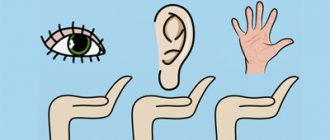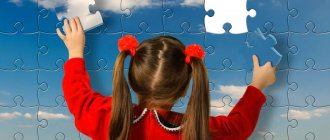Development of creativity
Creative thinking is necessary not only for people whose profession is related to art. The ability to think creatively and unconventionally helps a person in solving everyday problems, allows them to feel free, get out of hackneyed patterns, and see opportunities where others see shortcomings. How to develop creativity and creative thinking? This is what the article is about.
A person is considered to have creative thinking if:
- There is originality in his actions or thinking. He can create something unique and fundamentally new. He knows how to look for new opportunities even where, according to a person with ordinary thinking, they cannot exist. Creativity test: take one problem and find at least 20 ways to solve it within 15 minutes.
- There is flexibility, the ability to expand your perception, to see uniqueness in the ordinary. Everyone's levels of creativity are different, but in general these qualities should be present.
- There is the ability to generate different points of view. Factors and conditions do not matter in this case.
- There is the ability to quickly switch from one thought to another without compromising quality.
Creativity trainer for adults, TOP 6 exercises
Creativity trainer for adults
Since creativity is the ability to find something new, it is not surprising that all the proposed exercises are aimed at developing this particular trait and broadening one’s horizons. The age of development of creativity is unlimited, so both children and adults can practice.
Associations
This exercise is done like this. You need to name 4 words at random, and then come up with a criterion according to which one of them will be redundant. For example: the words “parrot”, “chair”, “minced meat”, “river”.
Criterion No. 1: The river is superfluous, because a parrot, a chair, minced meat can be in the house, but the river cannot.
Criterion No. 2: The river is superfluous because it is a liquid, and all other objects are not.
Criterion No. 3: River is superfluous, because it is the only word that is feminine.
More complex association options
- You need to make a list of 5 words, and then take the first and each subsequent word and find the commonality in them.
- Quickly, on the go, name 6 words, and then divide them into two columns according to one of the characteristics.
- Create a table of contents for a future article using any three words named at random. Then close your eyes and choose two words at random. With these words, on the fly, come up with a crime scene. Next, add a couple more words that will become evidence to solve the crime.
Questions
The question method is also great for developing creative thinking. You can do everything: refute hackneyed truths, reflect on history, be interested in the fate of humanity. You need to ask questions like these more often:
- Why exactly this way and not another way? It will help you get to the bottom of things and understand your motivation.
- Why not? Helps to reveal prohibitions, restrictions on the threshold to the positive.
- And if? Helps broaden your horizons and get away from hackneyed truths.
Maximum possibilities
Sometimes, if a person sees a good opportunity, he grabs it with a death grip. At this point, the door of his thinking slams shut, and all potential options disappear in the bud. The task is to remove this barrier, achieve a selection of ideas, and then choose the best. That is, you just need to generate ideas, think through all the possibilities without emotions as to whether they are good or not. It is better to start training your thinking with trifles, and then move on to serious tasks.
- Come up with 50 ways to use an empty plastic sour cream container.
- Find 100 ways to title a text.
Mental maps
Compiling mind cards will help you see new connections in a large piece of information. Grouped key concepts will help to structure, bring into a system, and then find new associations in the whole picture. The algorithm is as follows:
- Take blank A4 sheets, multi-colored markers and pencils.
- Place the paper horizontally.
- In the center you need to depict an exciting question in the form of some kind of sign.
- Draw rays from this sign in the form of lines. There should be a lot of rays, at least 10.
- On each line write the main solutions and ideas.
- To each ray you need to add associative words and concepts.
- Evaluate the result, try to find new relationships.
- Analyze the picture as a whole, connect with arrows what inspired new solutions.
- Cross out what is unnecessary.
6 words
You need to write down the essence of the problem in one sentence of six words. For example: “Pass driving exams with excellent marks,” “Master computer technology in a year of study.” Everything needs to be done clearly and quickly, and then this task must be implemented.
Associative exercises to develop creativity
As you know, everything new is well forgotten old. To create something original, you don't need to reinvent the wheel. You just need to find new connections between existing components. In this case, the best helpers are associations.
Task 1. A well-known technique for creating new uses for an ordinary item. Usually they suggest finding non-standard uses for a ballpoint pen or pencil. Try playing with the objects that surround you every day. For example, books can not only be read, but also made into a hiding place or a decorative element.
Task 2. For this exercise you will need a book, dictionary or just a magazine. Open any page and choose a random word. Write it down. Do the same thing again. Match the words with associations and try to find a pattern or distant connection between them. You can come up with a short story with them or decipher each one as an abbreviation. To improve the result, it is recommended to complete the task in pairs or in a group to hear the opinions of others.
Creativity trainer for children, TOP 10 exercises
Creativity trainer for children
The principle of working with children: everything should be bright, interesting and in the form of a game. Children have good memories, but they get tired when they get bored. If it is interesting, children will join the game with pleasure and will develop. Since children are initially more open and flexible than adults, it will be much easier for them to reveal their creative potential.
For the development of imagination
- You need to invent something that doesn't exist. It can be anything, even the most crazy ideas.
- Encourage your child to imagine himself as a pilot or captain of a ship. What would he do in case of danger?
- Make the baby move to some era of the past or future. What is going to be there? What kind of clothing, language, interior, historical events and objects? What would he do, for example, if he, a stranger, needed to survive in this environment?
Association method
Encourage your child to look at the clouds. And then say out loud what they look like. Perhaps the child will see animals, faces, facial expressions or plants.
3 magical colors
Take a palette of colors and invite your child to choose three shades that, in his opinion, go together. Then fill blank paper with these paints at random. At the end of the exercise, tell what the randomly painted sheet looks like.
Construction
No constructor needed. You need circles, squares and other shapes made of colored paper. Children will use them to put together pictures, figurines, houses and whatever they want.
Inventor
You need to name any two objects, and then dream about how they can be combined for benefit. For example, using a flashlight with keys to a lock, you can create a device that allows you to open doors in the dark.
Finish the drawing
You need to prepare sheets with half-drawn figures, plants, objects and ask your child to complete them.
Drawing to music
You can play your child something from the classics and ask him to close his eyes. And then ask what pictures and associations the music evokes. Then ask him to draw what he saw.
Continue the metaphor
This exercise is also suitable for little ones. The child will have to complete the comparison based on the principle of associations. For example:
- squeaks piercingly like...
- hungry as...
- smart as...
- reliable as...
- red like...
Make one book with another
This method is suitable for older children. You need to name at random two works of different style and genre, and then ask the child to “transfer” the characters from one book to another. You can also change the course of an event, “throw” the plot from book to book, or add something. At the same time, you can mix fantasy and historical novels, fairy tales and stories, heroes of the 18th century and heroes of our time.
Continue the story
This exercise can be done in a group. The presenter begins to come up with a story, then stops mid-sentence and shouts out the first word that comes to his mind.
The next participant continues the story, but precisely from this word. After a piece of narration, he shouts out another word, foreign to this creation. The next participant continues again and so on.
Take notes
“Creative people are note-taking experts,” writes Professor Guy Claxton. They have better developed visual thinking skills. In How to Find Ideas, Ingledew advises noticing, collecting, and using things that most people don't even see. It is active curiosity that can show that the world is, in fact, full of ideas.
Exercise: Have you noticed that shadows sometimes randomly form the outlines of letters or numbers? New forms can be seen by observing the play of light and shadow, the movement of the hands on a dial, or simply the weather. Spontaneous notes help reveal the essence of things.
Tips during the training process
Tips during the training process
In order for the development of creative potential to occur automatically and the exercises to be more effective, you need to follow these points:
- Be able to refuse. That is, do not grab the first idea, but put it aside and follow further with new options.
- Be able to distract yourself. That is, putting the problem aside, and then, with fresh thoughts, deal with it again.
- Don't be afraid to be funny . Any thought, even a crazy one, must be collected carefully as possible, at least theoretically. Developing creativity begins with the ability to believe in the impossible. Suffice it to remember that once “iron birds flying across the sky” were considered a sign of insanity.
- A fundamental rejection of the usual , using the motto. "It happened before. What else can you offer?
- Praise yourself even for small improvements . This is important because a satisfied brain becomes more accommodating and is not afraid to break away from reality.
Don't ignore absurd things
The absurd was an important component of people's creativity in the 19th and 20th centuries. Lewis Carroll and Edward Lear used it in literature, Monty Python staged absurd comic acts, and the Dadaists and Surrealists used the absurd to create their works of art.
Exercise: Use visual language to create something absurd. This should offend outside observers, provoke them to take some action, and even better, make them laugh.
Nice bonus
Nice bonus
The brain of a trained person allows him not only to be quick-witted and quickly solve problems. In adults, exercise develops balance and endurance, and a trained person’s mood improves. There is also healthy self-confidence and self-esteem.
In children, exercises develop memory, ingenuity, interest in learning and a rich imagination.
How to develop creativity and creative thinking? Regularly perform the above training to develop creativity and creative abilities. The main condition is regularity. At the same time, you can train anywhere. As soon as you have even a minute of time: in transport, in a traffic jam, in line to see the doctor, before going to bed, or vice versa, early in the morning. All technologies and techniques are effective, you just need to implement them. Within a month of training, the first results will be noticeable, and after a year, a trained person will radically change his life for the better.
Why develop creativity
Our brain by nature is designed to think according to a template and follow the majority. But with the development of creative thinking, a person begins to think completely differently. Instead of standard solutions to problems, our mind begins to produce completely new ideas. This applies not only to professional activities, but also to everyday affairs.
So creativity is important in many areas, for example, to attract new customers, optimize work processes, increase profits, and so on. That's why the value of this skill is growing so quickly.
Just like intelligence level, creativity level can be determined. They do not depend on each other in any way. Every person has their own potential. And with proper attention and persistence, you can undoubtedly develop creative thinking.
Try to interpret
Ideas are very easy to transform. Changing the shape or size of things can force you to think in new and unexpected directions. One idea gives birth to another: in this way you can glean many new thoughts from the creativity of other people.
Russian artist Wassily Kandinsky conveyed classical music through visual language. He chose colors to represent the emotions that music evoked and used them to create paintings.
Exercise: Convey the following words using typographic symbols as a visual rather than a linguistic tool: laziness, happiness, loud, soft.
Improvise
Improvisation is not a “lazy” way to think. It is a way of thinking and acting that helps make decisions in emergency situations, such as a fire, a shipwreck, or a fight.
Exercise: The author of the book suggests doing an exercise called “The Creative Path”. It is similar to the “Food Road” project, when the entire path of food products is marked on a map - from the point of production to the dinner table. The campaign championed local food producers. Their products reach customers faster, which means firms spend less resources on production.
The “creative path” suggests that you use only what is at hand to work. Try solving problems using objects that are already on your desk or in your bag. Firstly, it will teach you to improvise, and secondly, you will free yourself from additional work that requires movement.
Creative skills
Each of us has an inherent desire to create. And we can develop this enormous creative potential without restrictions. By creating, a person changes the world around him. And the result of such creative activity is his growth and changes in himself. Thus, the generation of innovations and creative solutions for a creative person is a continuous search for oneself.
Read our article “What is a book of shadows and how to use it.”
Many people are mistaken in thinking that creative abilities are only the ability to write poetry, works in prose, compose music or draw. Our level of development of creative potential affects how we perceive the world and who we feel like in it. People with a low level are characterized by a tendency to increased self-criticism, the manifestation of dissatisfaction not only with themselves, but also with others and the world around them.
Change the context
A small change in ordinary things can lead to a new idea. It can be found by changing the point of view on the subject or changing the context in which it is located.
In 1917, at the exhibition of the Society of Independent Artists, Marcel Duchamp presented his exhibit “Fountain”. It was a urinal laid flat: thus the changed context became an element of the work of art.
Exercise: Highlight something inconspicuous. For example, go to a building materials store and find an inexpensive product. Think about how it can be used in an unusual way.
Create the right conditions
To come up with ideas quickly and regularly, you need to understand in what conditions it is easier for you to work. Russian composer Pyotr Ilyich Tchaikovsky mused: “If we wait for the mood without trying to create it ourselves, we will quickly become lazy and apathetic.”
Exercise: Learn about the creative process of famous people. For example, the German poet Friedrich Schiller said that it was easier for him to work if he could smell rotting apples.
Ways to be more creative
Today, creativity as a trait and skill is highly valued. This happens because creativity is about solving problems and finding ways around obstacles. It will come in handy during an interview to show yourself as an outstanding worker who can cope with tasks. In the company of friends you won't get bored. And in business, everything is often built around non-standard solutions and new ideas. Therefore, in our time, being creative is not fun, but rather a vital necessity. We bring to your attention ways in which you can increase your creative level. Read more…
10










